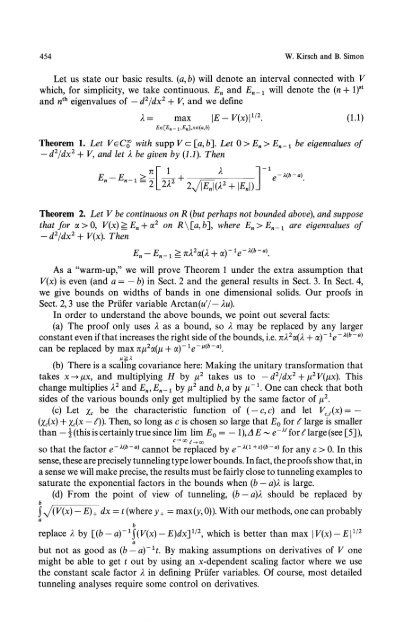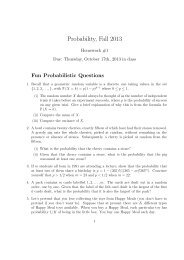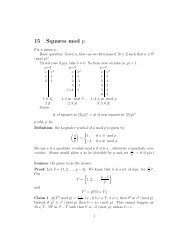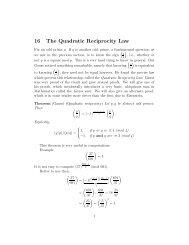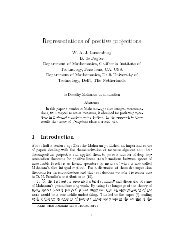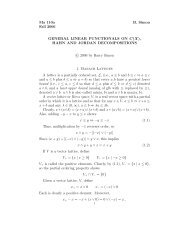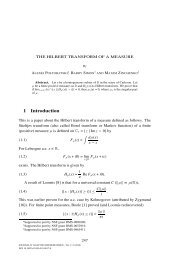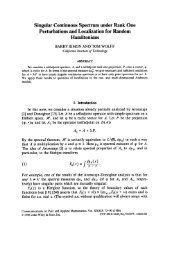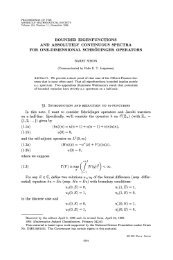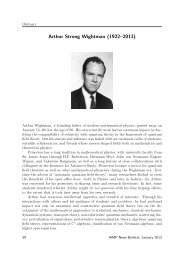Physics Universal Lower Bounds on Eigenvalue Splittings ... - Caltech
Physics Universal Lower Bounds on Eigenvalue Splittings ... - Caltech
Physics Universal Lower Bounds on Eigenvalue Splittings ... - Caltech
You also want an ePaper? Increase the reach of your titles
YUMPU automatically turns print PDFs into web optimized ePapers that Google loves.
454 W. Kirsch and B. Sim<strong>on</strong><br />
Let us state our basic results, (α, fo) will denote an interval c<strong>on</strong>nected with V<br />
which, for simplicity, we take c<strong>on</strong>tinuous. En and En_ί will denote the (n+ l) st<br />
and n ih<br />
eigenvalues of — d 2<br />
/dx 2<br />
+ F, and we define<br />
λ= max \E-V(x)\ 1/2 . (1.1)<br />
£e[£ ll-i,£ B],xe(β,6)<br />
Theorem 1. Lei FeQ? wiίft supp F cz [α, fo]. Lei 0>E n >£ n_! foe eigenvalues of<br />
- d 2<br />
/dx 2<br />
+ F, and feί /I foe #*ι;en by (1.1). Then<br />
Theorem 2. Let V be c<strong>on</strong>tinuous <strong>on</strong> R (but perhaps not bounded above), and suppose<br />
that for a>0, F(x)^£ + a M 2 <strong>on</strong> #\[a,fo], where E >E _ n n 1 are eigenvalues of<br />
-d 2 /dx 2 + V(x). Then<br />
E n - E n . ί ^ πλ 2 oc(λ + a)- l e-W- a \<br />
As a "warm-up," we will prove Theorem 1 under the extra assumpti<strong>on</strong> that<br />
V(x) is even (and a = — fo) in Sect. 2 and the general results in Sect. 3. In Sect. 4,<br />
we give bounds <strong>on</strong> widths of bands in <strong>on</strong>e dimensi<strong>on</strong>al solids. Our proofs in<br />
Sect. 2,3 use the Prϋfer variable Arctan(u'/ — λu).<br />
In order to understand the above bounds, we point out several facts:<br />
(a) The proof <strong>on</strong>ly uses A as a bound, so λ may be replaced by any larger<br />
c<strong>on</strong>stant even if that increases the right side of the bounds, i.e. πλ 2 a(λ + oί)~ 1 e~ λ{b ~ a)<br />
can be replaced by max πμ 2 oc(μ + oc)~ 1 e~ μ{b ~ a) .<br />
(b) There is a scaling covariance here: Making the unitary transformati<strong>on</strong> that<br />
takes x-^μx, and multiplying H by μ 2 takes us to — d 2 /dx 2 + μ 2 V(μx). This<br />
change multiplies λ 2 and E ,E _ by μ n n 1<br />
2 and fo, a by μ~ 1 . One can check that both<br />
sides of the various bounds <strong>on</strong>ly get multiplied by the same factor of μ 2<br />
.<br />
(c) Let χc be the characteristic functi<strong>on</strong> of (— c, c) and let Vc/(x) = —<br />
(χc(x) + χc(x — /))• Then, so l<strong>on</strong>g as c is chosen so large that Eo for £ large is smaller<br />
than —\(this is certainly true since lim lim Eo= — l\ΔE ~ e~ λe ίoτ£ large (see [5]),<br />
so that the factor e~ λ(b ~ a) cannot be replaced by e~ λ(1 +ε H & -«) for any ε > 0. In this<br />
sense, these are precisely tunneling type lower bounds. In fact, the proofs show that, in<br />
a sense we will make precise, the results must be fairly close to tunneling examples to<br />
saturate the exp<strong>on</strong>ential factors in the bounds when (fo — a)λ is large.<br />
(d) From the point of view of tunneling, (fo — a)λ should be replaced by<br />
a<br />
— E) + dx = ί(wherey + =max(y,0)). With our methods, <strong>on</strong>e can probably<br />
replace λ by [(b-a)- 1<br />
$(V(x)-E)dx] 1/2<br />
a<br />
9<br />
which is better than max |F(x)-£| 1/2<br />
but not as good as (fo — a)~ 1<br />
t. By making assumpti<strong>on</strong>s <strong>on</strong> derivatives of F <strong>on</strong>e<br />
might be able to get t out by using an x-dependent scaling factor where we use<br />
the c<strong>on</strong>stant scale factor λ in defining Prϋfer variables. Of course, most detailed<br />
tunneling analyses require some c<strong>on</strong>trol <strong>on</strong> derivatives.


